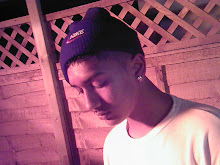WWW: In our presentation we informed the class about what our production idea was. Firstly, we had limited amoutn of writing on our slides and then expanded during the presentation to explain to the class what it is we were talking about. Furthermore, we looked at some key terminology and explained and expanded whilst informing the class at the same time, some of this terminology included; Stereotypes of young teens and what kinds of people we will be looking at in our production. We also included some reference to audience theory and stated how our production will link to interesting the audience. Lastly, we also carefully considered the where will show our film and the time.
EBI: One the other hand, we did not elaborate on a key point in our production; 'Moral panic' which is one thing that our production will suggest as an outcome of young teenagers. We could have also used key theory's and should not have been so vague in our approach and statements. The last two slides were of a poor standard because there was to much text and whereas it should have been a couple of words that help us expand the points in class. Finally, we should have also used pictures to add a visual aspect to our presentation and could have used genre conventions to suggest to the class why our production will appeal to a certain audience.
Next Steps and Progress Report for the following week
Monday: Research '4 Docs' (online/ textbook)
Tuesday: Research into my genre
Wednesday: Interviews/ shots (using external mic)
Thursday: Research into similar texts (Ross Kemp On Gangs: London)
Friday: Interviews/ shotscenes (using external mic)
Saturday: Interviews/ shots (using external mic)
Sunday: Interviews/ shots (using external mic)
Action Plan
Week 1: Research into our genre looking at Ross Kemp On Gangs, taking notes on codes and conventions. Also, storyboard our shots and write down key notes e.g. lighting. Lastly, brainstorm locations, ideas, people we are going to interview.
Week 2: Scripting what we are going to say in the interviews and what we want peopel to say. Being doing interviews, take shots and begin organising our shots by putting them on computer and using as many codes and conventions as possible.
Week 3: Do interviews, take shots and begin organising our shots by putting them on computer and using as many codes and conventions as possible. Whilst doing this we are going to research into our genre and continue looking at other texts.
Week 4: Last set of shots if needed and start editing after school and organising our shots in order to edit easily. During this we are going to begin our critical investigation final.
Week 5: Continue editing but at this point we will be editing at as many chances we can (after school, frees etc) and work on our critical investigation at home using research we have.
Week 6: Then put in our final edits and tweek our production to complete the project.
Research into my genre and similar texts
Similar Text: 'Ross Kemp On Gangs'
Narrative: On the show Kemp travels around the world talking to gang members, locals who have been affected by gang violence, and the authorities who are attempting to combat the problem. In each episode he attempts to establish contacts within the gangs who can arrange interviews with the gangs' leaders.
- http://en.wikipedia.org/wiki/Ross_Kemp_on_Gangs
Representation: This show represents gangs to be violent and corrupt but it also takes a deeper look into the reason behind the making of the gang, why they do what they do and how this life has effected them physically, mentally and emotionally. Gang members are shown to be aggressive and anti-social and the cities are portrayed as poor, unwealthy places to live.
Conventions: They use a voiceover on the show, interviews and show life how it is no camera edits. Props like guns, knives etc,low key lighting when showing the gangsters. He also wears casual costume and a normal attire, jeans and tshirt that are usually colours like black so he does not offend any gangs with the colours he wears. Not many close up shots except when showing gun wounds etc, generally medium shots or medium close ups, set in various places like; Mexico, many places in LA, Brazil and across Europe. We will specifically look at the London episode.
Genre: Documentary film is a broad category of visual expressions that is based on the attempt, in one fashion or another, to "document" reality. Although "documentary film" originally referred to movies shot on film stock, it has subsequently expanded to include video and digital productions that can be either direct-to-video or made for a television series. Documentary, as it applies here, works to identify a "filmmaking practice, a cinematic tradition, and mode of audience reception" that is continually evolving and is without clear boundaries.
